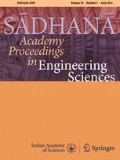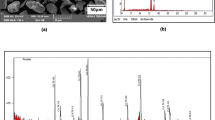Abstract
This paper aims at developing an empirical relation to predict the porosity and micro-hardness, by means of High Velocity Oxy Fuel (HVOF) sprayed WC-10Co-4Cr coatings. For determining the coating performance, process parameters such as flow rate of LPG fuel, flow rate of oxygen, spray distance, flow rate of carrier gas and feed rate of the coating powder play a significant role. Five-factors, five-level central composite rotatable design (CCD) was employed in this analysis to reduce the number of experiments by covering all possible combinations of the process variables. A mathematical model was established to assess the porosity and microhardness of the coatings including HVOF process parameters and the appropriateness of the model was examined using analysis of variance. Using RSM, process parameter optimizations were conducted. The coatings produced using optimized process variables had a minimum porosity level of 0.2 Vol. percentage and a maximum hardness of 1325.26 HVx compared to other coatings. This has been confirmed by the developing response graphs and also by plotting contours. The optimization of HVOF parameters using RSM, as well as the correlation of spray variables with properties of the coating, enables the recognition of the framework of the characteristics to attain the preferred consistency of WC-10Co-4Cr coatings. Analysis of Sensitivity is also performed to determine the most significant process parameter for the HVOF operation.













Similar content being viewed by others
Abbreviations
- A:
-
Oxygen flow rate
- B:
-
LPG flow rate
- C:
-
Powder feed rate
- D:
-
Stand-off distance
- E:
-
Carrier gas flow rate
- HVx :
-
Hardness value
References
Aw P K and Tan B H 2006 Study of microstructure, phase and micro hardness distribution of HVOF sprayed multi modal structured and conventional WC–17Co coatings. J. Mater. Process. Technol. 174(1): 305–311
Wang Q, Luo S, Wang S, Wang H and Ramachandran C S 2019 Erosion and corrosion resistance of HVOF-sprayed WC and Cr3C2 based coatings for electrolytic hard chrome replacement. Int. J. Refract. Met. Hard Mater. 81: 242–252
Ahuja L, Mudgal D, Singh S and Prakash S 2018 A comparative study to evaluate the corrosion performance of Zr incorporated Cr3C2-(NiCr) coating at 900°C. Ceram. Int. 44(6): 6479–6492
Liu Y, Liu W, Ma Y and Meng S 2017 A comparative study on wear and corrosion behaviour of HVOF- and HVAF-sprayed WC–10Co–4Cr coatings. Surf. Eng. 33(1): 63–67
Ding X, Ke Du, Yuan C and Zhangxiong D 2018 Microstructure and cavitation erosion resistance of HVOF deposited WC-Co coatings with different sized WC. Coatings 8(9): 307
Santana Y Y, Renault P O, Sebastiani M and La Barbera-Sosa J G 2008 Characterization and residual stresses of WC–Co thermally sprayed coatings. Surf. Coat. Technol. 202(18): 4560–4565
Liu X, Kang J, Yue W, Fu Z, Zhu L, She D, Liang J and Wang C 2019 Performance evaluation of HVOF sprayed WC-10Co-4Cr coatings under slurry erosion. Surf. Eng. 35(9): 816–825
Bansal A, Singh J and Singh H 2019 Slurry erosion behavior of HVOF sprayed WC-10Co-4Cr coated SS 316 steel with and without PTFE modification. J. Thermal Spray Technol. 28(19): 1448–1465
Guo X, Planche M P, Chen J and Liao H 2014 Relationships between in-flight particle characteristics and properties of HVOF sprayed WC-Co-Cr coatings. J. Mater. Process. Technol. 214(2): 456–461
Liu X, Kang J, Yue W, Fu Z, Zhu L, She D, Liang J and Wang C 2019 Performance evaluation of HVOF sprayed WC-10Co-4Cr coatings under slurry erosion. Surf. Eng. 370(9): 1–11
Bansal P, Shipway P H and Leen S B 2007 Residual stresses in high-velocity oxy-fuel thermally sprayed coatings—modelling the effect of particle velocity and temperature during the spraying process. Acta Materialia 55(15): 5089–5101
Dyshlovenko S, Pawlowski L, Roussel P, Murano D and Maguer A E 2006 Relationship between plasma spray operational parameters and microstructure of hydroxyapatite coatings and powder sprayed into water. Surf. Coat. Technol. 200(12–13): 3845–3855
Fang W, Cho T Y, Yoon J H, Song K O, Hur S K, Youn S J and Chun H G 2009 Processing optimization, surface properties and wear behavior of HVOF spraying WC-CrC-Ni coating. J. Mater. Process. Technol. 209(7): 3561–3567
Ramachandran C S, Balasubramanian V and Ananthapadmanabhan P V 2012 Synthesis, spheroidization and spray deposition of lanthanum zirconate using thermal plasma process. Surf. Coat. Technol. 206(13): 3017–3035
Murugan K, Ragupathy A, Balasubramanian V and Sridhar K 2014 Developing empirical relationships to predict hardness in WC-Co-Cr HVOF sprayed coating. Proc. Mater. Sci. 5: 918–927
Kiragi V R, Patnaik A, Singh T and Fekete G 2019 Parametric optimization of erosive wear response of TiAlN-coated aluminium alloy using Taguchi method. J. Mater. Eng. Perform. 28(1): 838–851
Datta S, Pratihar D K and Bandyopadhyay P P 2012 Modeling of input–output relationships for a plasma spray coating process using soft computing tools. Appl. Soft Comput. 12(11): 3356–3368
Vaidya A, Srinivasan V, Streibl T, Friis M, Chi W and Sampath S 2008 Process maps for plasma spraying of yttria-stabilized zirconia: an integrated approach to design, optimization and reliability. Mater. Sci. Eng. A 497(1–2): 239–253
Oksa M, Turunen E, Suhonen T, Varis T and Hannula S P 2011 Optimization and characterization of high velocity oxy-fuel sprayed coatings: techniques, materials, and applications. Coatings 1(1): 17–52
Mawdsley J R, Su Y J, Faber K T and Bernecki T F 2001 Optimization of small-particle plasma-sprayed alumina coatings using designed experiments. Mater. Sci. Eng.: A 308(1–2): 189–199
Lin B T, Jean M D and Chou J H 2007 Using response surface methodology with response transformation in optimizing plasma spraying coatings. Int. J. Adv. Manuf. Technol. 34(3): 307–315
Ramachandaran C S, Balasubramanian V and Ananthapadmanbhan P V 2010 Multiobjective optimization of atmospheric plasma spray process parameters to deposit yttria-stabilized zirconia coatings using response surface methodology. J. Thermal Spray Technol. 20(3): 590–607
ASTM B276-05 2015 Standard Test Method for Apparent Porosity in Cemented Carbides. ASTM International, West Conshohocken
ASTM C633-01 2008 Standard Test Method for Adhesion or Cohesion Strength of Thermal Spray Coatings. ASTM International, West Conshohocken
Vignesh S, Shanmugam K, Balasubramanian V and Sridhar K 2017 Identifying the optimal HVOF spray parameters to attain minimum porosity and maximum hardness in iron based amorphous metallic coatings. Def. Technol. 13(2): 101–110
Tillman W, Vogli E, Baumann I, Kopp G and Weihs C 2010 Desirability-based multi-criteria optimization of HVOF Spray experiments to manufacture fine structured wear-resistant 75Cr3C2-25(NiCr20) coatings. J. Thermal Spray Technol. 19(1): 392–408
Khuri A I and Cornell J A 1996 Response Surfaces; Design and Analysis. Marcel Dekker Ltd, New York
Ding Y, Zhu L, Zhang X and Ding H 2012 Response sensitivity analysis of the dynamic milling process based on the numerical integration method. Chin. J. Mech. Eng. 25(5): 940–946
Palani P K and Murugan N 2006 Sensitivity analysis for process parameters in cladding of stainless steel by flux cored arc welding. J. Manuf. Process. 8(2): 90–100
Acknowledgements
The authors wish to express their deepest gratitude to the Department of Manufacturing Engineering, Annamalai University, Tamil Nadu, India for providing the facilities for coating characterization.
Author information
Authors and Affiliations
Corresponding author
Rights and permissions
About this article
Cite this article
Prasad, R.V., Rajesh, R., Thirumalaikumarasamy, D. et al. Sensitivity analysis and optimisation of HVOF process inputs to reduce porosity and maximise hardness of WC-10Co-4Cr coatings. Sādhanā 46, 149 (2021). https://doi.org/10.1007/s12046-021-01667-4
Received:
Revised:
Accepted:
Published:
DOI: https://doi.org/10.1007/s12046-021-01667-4




